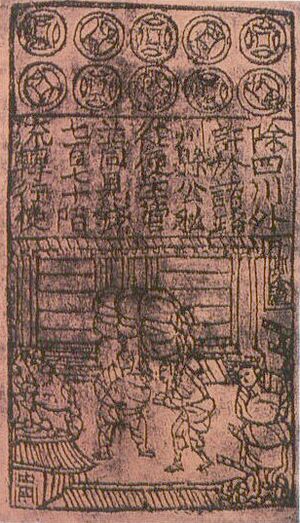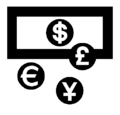Currency facts for kids
A currency is a special kind of money that helps people buy and sell things. It's a way to trade goods and services easily. Think of it as a tool for exchange. A currency zone is an area, like a country or a group of countries, where a certain currency is mostly used.
When countries trade with each other, they use exchange rates. An exchange rate is like a price that tells you how much one currency is worth compared to another. For example, it tells you how many US dollars you can get for one Euro. Modern currencies can either have floating or fixed exchange rates. This depends on how their value is decided in the world market.
Contents
How Money Began
Money has changed a lot over time. Long ago, people used different things as currency. These early forms of money helped people keep track of what they owned and what they traded.
From Counters to Metal
The idea of currency started with two main inventions. First, people used counters to make sure that goods shipped from one place arrived correctly. Second, they began using silver bars, called ingots, to represent stored value, like a large amount of grain. Both of these ideas were used by 2000 BC. This early way of using metals to show value was the basis of trade for over 1,500 years!
The Invention of Coins
Over time, people started using the metal itself as the main form of value. At first, it was silver, then both silver and gold. These metals were dug up from the ground, weighed, and then stamped into coins. The stamp on a coin told people that it had a certain, known weight of valuable metal.
Coins made it easier to trade. Even though some people tried to make fake coins, they also created a new way to count value, which helped lead to banking.
In many big economies, coins were made in three different types of metal: copper, silver, and gold.
- Gold coins were used for very large purchases, like paying soldiers or funding government activities.
- Silver coins were used for bigger, but more common, transactions. They were also used to set prices for taxes, payments, and agreements.
- Copper coins were for everyday small purchases.
Famous Currencies
Some well-known currencies around the world include:
- The United States dollar
- The Euro
- The British pound
World Currencies by Name
Here are some currency names from around the world, listed in alphabetical order:
- Afghani - Afghanistan
- Baht - Thailand
- Balboa - Panama (the U.S. dollar is used for paper money)
- Birr - Ethiopia
- Bolívar - Venezuela
- Boliviano - Bolivia
- Cedi - Ghana
- Colón - Costa Rica
- Cordoba - Nicaragua
- Crown - Used in the Czech Republic (koruna), Denmark (krone), Estonia (kroon), Iceland (króna), Norway (krone), Sweden (krona).
- Dalasi - The Gambia
- Dinar - Used in Algeria, Bahrain, Iraq, Jordan, Kuwait, Serbia, Tunisia
- Dirham - Used in Morocco, United Arab Emirates, Libya, Qatar, Jordan
- Dollar - Used in many countries
- Dong - Vietnam
- Drachma - Used to be in Greece (now uses the euro)
- Dram - Armenia
- Escudo - Used in Cape Verde (used to be in Portugal, now uses the euro)
- Euro - Used in many European countries
- Forint - Hungary
- Franc - Used in several countries
- Gourde - Haiti
- Guilder - Used in Aruba, Netherlands Antilles (used to be in Netherlands, now uses the euro)
- Iranian real - Iran
- Kina - Papua New Guinea
- Koruna - Czech Republic (used to be in Slovakia, now uses the euro)
- Kroon - Estonia
- Krona - Iceland, Sweden
- Krone - Denmark, Faroe Islands, Greenland, Norway
- Kuna - Croatia
- Kwacha - Zambia and Malawi
- Kwanza - Angola
- Kyat - Burma
- Lari - Georgia
- Lats - Latvia
- Lek - Albania
- Lempira - Honduras
- Leone - Sierra Leone
- Leu - Romania, Moldova
- Lev - Bulgaria
- Lira - Used to be in Cyprus, Italy, San Marino, Vatican City (now use the euro)
- Litas - Lithuania
- Manat - Used in some countries
- Mark - Used to be in Germany (now uses the euro)
- Marka - Bosnia and Herzegovina
- Markka - Used to be in Finland (now uses the euro)
- Nakfa - Eritrea
- Namibian dollars - Namibia
- Ngultrum - Bhutan
- Pataca - Macau
- Peseta - Used to be in Andorra, Spain (now use the euro)
- Peso - Used in Argentina, Chile, Colombia, Cuba, Dominican Republic (Dominican peso), Mexico, Philippines, Uruguay
- Pound - Used in Cyprus, Egypt, Falkland Islands, Gibraltar, Guernsey, Jersey, United Kingdom
- Pula - Botswana
- Quetzal - Guatemala
- Rand - South Africa
- Real - Brazil
- Renminbi - People's Republic of China
- Riel - Cambodia
- Ringgit - Malaysia
- Riyal - Saudi Arabia
- Rouble - Belarus, Russia
- Rufiyah - Maldives
- Rupee - Used in Republic of India, Mauritius, Nepal, Pakistan, Seychelles, Sri Lanka
- Rupiah - Indonesia
- Schilling - Used to be in Austria (now uses the euro)
- Shekel - Israel, Gaza Strip, West Bank
- Shilling - Kenya
- Sol - Peru
- Som - Kyrgyzstan
- Sucre - Ecuador
- Taka - Bangladesh
- Tenge - Kazakhstan
- Tolar - Slovenia
- Toman - Iran
- Won - North Korea, South Korea
- Yen - Japan
- Yuan - People's Republic of China
- Zloty - Poland
Images for kids
See also
 In Spanish: Moneda (divisa) para niños
In Spanish: Moneda (divisa) para niños





















